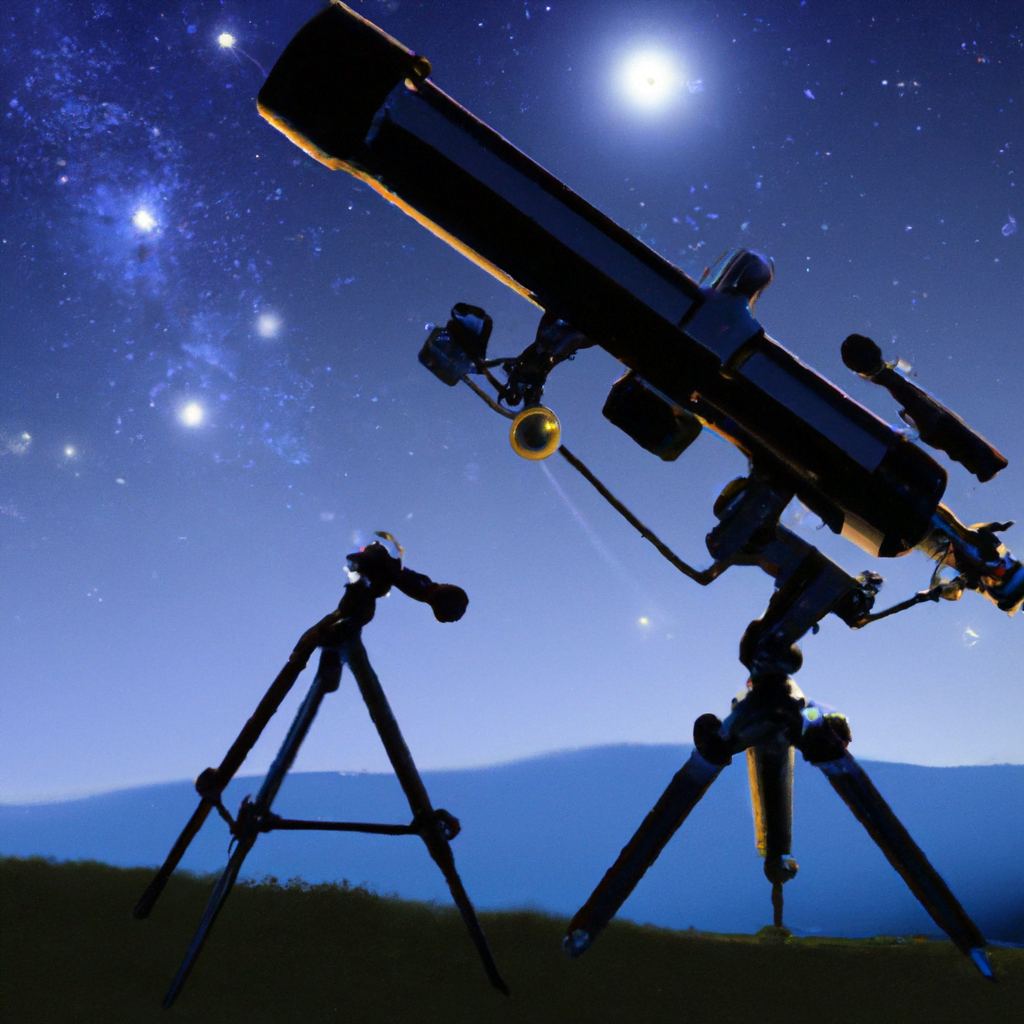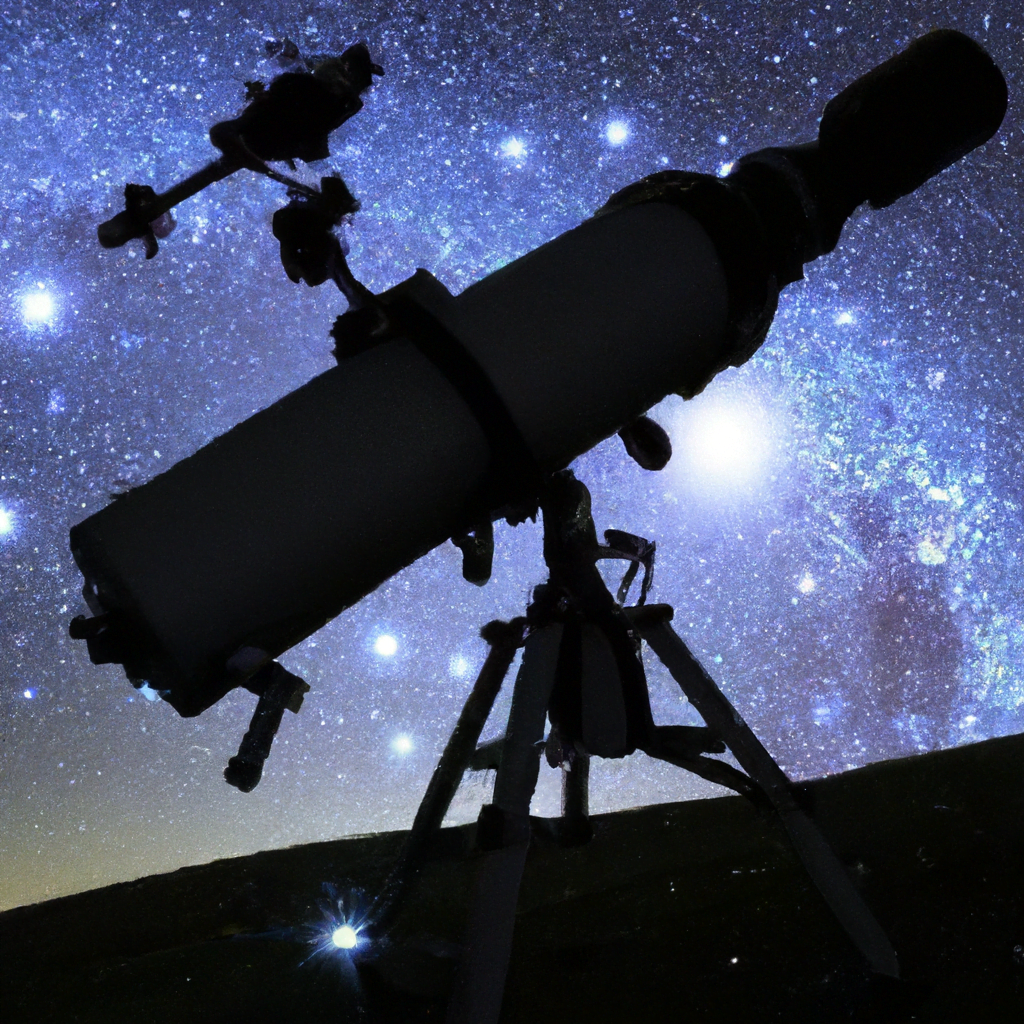Have you ever wondered how to use star charts or planispheres with telescopes? If so, you’re in the right place! Exploring the night sky can be an exciting and rewarding experience, but it can also be overwhelming without the proper tools and knowledge. In this article, we will guide you through the process of using star charts or planispheres with telescopes, helping you navigate the vast expanse of stars and unlock the wonders of the universe. So grab your telescope, put on your stargazing hat, and let’s embark on a celestial adventure together!
Table of Contents
Finding the Right Tools for Observing the Night Sky
Observing the night sky can be a fascinating and rewarding experience. To make the most of your stargazing adventures, it’s important to have the right tools at your disposal. Two essential tools for navigating the night sky are star charts and planispheres.
What are star charts and planispheres?
Star charts and planispheres are tools used by astronomers and stargazers to locate and identify constellations, stars, and other celestial objects in the night sky. They provide a visual representation of the stars and their positions relative to each other.
A star chart is a map of the night sky, typically printed on paper or found in astronomy books. It displays the stars, constellations, and other objects visible from a specific location and at a particular time.
On the other hand, a planisphere is a circular device that can be adjusted to display the night sky for any date and time. It consists of a rotating disk with a transparent overlay representing the visible stars and constellations for a specific location.
Types of star charts
There are different types of star charts available to suit varying needs and levels of expertise. Some popular types include:
Sky atlases: These are detailed maps of the entire night sky, including faint stars and deep-sky objects. Sky atlases are often used by advanced astronomers and those interested in deep-sky observing.
Constellation charts: These charts focus on the identification and location of specific constellations. They are great for beginners and those who want to explore the mythology and stories behind each constellation.
Deep-sky object charts: These charts highlight specific celestial objects such as nebulae, star clusters, and galaxies. They are valuable tools for those who want to observe faint and distant objects beyond our solar system.
Benefits of using star charts or planispheres
Using star charts or planispheres has several advantages for stargazers of all levels. Here are a few benefits:
Enhanced knowledge: By using star charts or planispheres, you can deepen your understanding of the night sky. You’ll become familiar with the names, positions, and characteristics of stars and constellations.
Navigational aid: Star charts and planispheres act as a reliable map for navigating the night sky. They can help you locate specific objects or constellations with precision, ensuring a satisfying observing experience.
Increased appreciation: With the aid of star charts or planispheres, you’ll be able to appreciate the vastness and beauty of the night sky even more. The ability to identify constellations and stars adds another layer of awe to your stargazing adventures.
Getting Familiar with Your Telescope
A telescope is an indispensable tool for observing celestial objects in greater detail. Whether you are a beginner or an experienced observer, understanding the different parts of a telescope is crucial in optimizing its use.
Understanding the different parts of a telescope
Telescopes come in various designs and configurations, but they all have common components. Here are the key parts you should be familiar with:
Objective lens or mirror: This is the main component that collects and focuses light from celestial objects. In refracting telescopes, it is a lens, while in reflecting telescopes, it is a mirror.
Eyepiece: The eyepiece is placed at the back of the telescope and magnifies the image formed by the objective lens or mirror, allowing you to see celestial objects in greater detail.
Focuser: The focuser allows you to adjust the position of the eyepiece so that the image is sharp and clear. It is used to achieve proper focus during observations.
Mount: The mount holds the telescope and allows it to move in different directions. There are two main types of mounts: altitude-azimuth (Alt-Az) mounts, which move vertically and horizontally, and equatorial mounts, which align with the rotation of the Earth.
Setting up and aligning your telescope
Once you have a good understanding of your telescope’s parts, it’s time to set it up. Follow these steps for a successful setup:
Choose a stable and level observing location away from sources of vibration or artificial lights. This will ensure the best possible viewing conditions.
Assemble your telescope according to the manufacturer’s instructions. Take care not to force any parts and ensure that everything is securely attached.
Attach the mount to the tripod and make sure it is stable. Adjust the tripod legs to achieve a comfortable height for observation.
Balance the telescope by adjusting the counterweights on an equatorial mount or by placing them correctly on the mount’s counterweight shaft.
Align the finder scope with the main telescope. This can be done by pointing the telescope at a distant object (such as a hill or a building) and adjusting the finder scope until the object is centered in both the telescope’s view and the finder scope’s crosshairs.
Calibrating your telescope for accurate observations
Before embarking on your stargazing journey, it’s essential to calibrate your telescope to ensure accurate observations. Here are a few calibration techniques to consider:
Collimation: Collimation refers to aligning the optical elements of a telescope, such as the mirrors or lenses, to ensure that light is properly focused. Many telescopes come with collimation tools or instructions to help you achieve optimal alignment.
Polar alignment: For observers using equatorial mounts, polar alignment is crucial for tracking celestial objects accurately. By aligning the mount with the Earth’s rotation axis, you can counteract the apparent motion of the stars due to the Earth’s rotation.
Autoguiding: Advanced telescopes offer autoguiding capabilities, where a separate camera is used to track a reference star. This helps to compensate for any tracking errors in the mount and allows for long-exposure astrophotography.
Taking the time to familiarize yourself with your telescope and properly setting it up and aligning it will ensure more enjoyable and accurate observing sessions.

Using Star Charts and Planispheres to Navigate the Sky
Star charts and planispheres are invaluable tools for finding and identifying celestial objects in the night sky. Here’s how you can use them effectively:
Identifying constellations and stars on the chart or planisphere
To begin using a star chart or planisphere, familiarize yourself with the layout and functionality of the tool. Start by identifying major constellations and stars on the chart or rotating the planisphere to match your desired observation time.
Look for prominent features, such as the Big Dipper or Orion’s Belt, and trace the patterns that make up each constellation. By connecting the dots, you can visualize the shapes and figures represented by the stars.
Aligning your star chart or planisphere with the night sky
Once you have identified specific constellations or stars on your star chart or planisphere, aligning it with the night sky is crucial for accurate observation. Follow these steps:
Determine your location: Note your latitude and longitude or use a GPS device to pinpoint your observing site. This ensures that your chart or planisphere corresponds accurately with your position on Earth.
Account for the date and time: Star charts and planispheres are designed for specific dates and times. Ensure that your chart or planisphere matches your exact observing time to accurately reflect the positions of the stars and constellations.
Orient your chart or planisphere: If using a star chart, face north and rotate the chart so that the north on the chart aligns with the north in the sky. If using a planisphere, rotate the disk until the current date and time align with the outer ring, and the desired observation time appears in the window.
By aligning your chart or planisphere correctly, you can now confidently navigate the night sky and locate celestial objects with ease.
Locating specific objects or celestial events
Once you have familiarized yourself with star charts or planispheres, you can take your stargazing experience to the next level by locating specific objects or tracking celestial events. Here are a few tips:
Use reference stars: Reference stars are bright stars that can serve as guideposts to find other objects. By identifying and locating reference stars on your chart or planisphere, you can navigate to nearby objects such as nebulae, star clusters, or galaxies.
Plan for special events: Star charts and planispheres can help you plan for special celestial events, such as meteor showers, eclipses, or the appearance of bright comets. By referencing your chart or planisphere, you can determine the best time and direction to view these events.
Take note of magnitude: Star charts often include magnitude information, which indicates the brightness of a star or celestial object. By paying attention to the magnitude, you can gauge how visible an object will be from your location and choose your targets accordingly.
Using star charts or planispheres to navigate the night sky takes practice, but with time and experience, you’ll become more adept at locating and observing various celestial objects.
Steps for Effective Observation
Observing the night sky requires careful planning and consideration of various factors. Here are some steps to ensure an effective and enjoyable stargazing session:
Beginner tips for using star charts or planispheres
If you are new to using star charts or planispheres, here are a few tips to get you started:
Start with familiar constellations: Begin by identifying and observing well-known constellations such as the Big Dipper, Orion, or Cassiopeia. These easily recognizable patterns will help you gain confidence and familiarity with using star charts or planispheres.
Begin with larger objects: When selecting targets for observation, start with larger and brighter objects such as the Moon, planets, or bright star clusters. These objects are easier to locate and require less magnification to see details.
Take it slow: Observing the night sky is not a race. Take your time to appreciate the objects you observe. Spend moments just looking up and enjoying the vastness of space.
Finding the optimal viewing location
Choosing the right location for stargazing is crucial for optimal viewing conditions. Here are a few considerations:
Minimize light pollution: Find a location away from city lights, streetlights, and other sources of light pollution. Light pollution can significantly reduce the visibility of faint stars and make it harder to observe celestial objects.
Check weather conditions: Clear skies are essential for observing the night sky. Check weather forecasts and choose a night when the weather conditions are favorable, with minimal cloud cover and atmospheric disturbances.
Gain elevation if possible: If you have the opportunity, choose a location with higher elevation. Being at a higher altitude can provide a clearer view of the sky and reduce atmospheric disturbances.
Making note of environmental conditions
To accurately record and document your observations, it’s important to note the environmental conditions at the time of observation. Here are a few factors to consider:
Temperature and humidity: Temperature and humidity can affect the clarity of the night sky and the performance of your equipment. Note any significant temperature changes or changes in atmospheric moisture.
Wind conditions: Strong winds can cause your telescope to vibrate and result in blurry images. Be aware of wind conditions and adjust your setup if necessary to minimize vibrations.
Light pollution and sky glow: Keep a record of the level of light pollution and sky glow present at your observing location. This information can help you assess the quality of your observations and make adjustments for future sessions.
By following these steps, you can ensure a more productive and enjoyable stargazing experience.

Advanced Techniques for Accurate Observations
Once you have become comfortable using star charts or planispheres and have a good understanding of your telescope, you can explore advanced techniques to enhance your observations.
Using a red flashlight to preserve night vision
Preserving your night vision is crucial for observing faint celestial objects. Bright lights can cause your eyes to adapt and reduce your ability to see faint stars. To preserve your night vision, use a red flashlight or cover your regular flashlight with red film or cellophane. Red light is least disruptive to night vision, allowing you to navigate your chart or planisphere without compromising your ability to see in the dark.
Utilizing different magnifications and eyepieces
Experimenting with different magnifications and eyepieces can enhance your viewing experience. Higher magnifications can bring out finer details on the Moon and planets, while lower magnifications provide a wider field of view, allowing you to observe larger objects such as star clusters or nebulae. Invest in a selection of eyepieces with varying focal lengths to achieve a range of magnifications.
Tracking objects with your telescope’s mount
Once you have located an object, keeping it within the field of view can be challenging, especially when observing at high magnifications. Most telescopes are equipped with an Alt-Az or equatorial mount that allows you to track celestial objects as the Earth rotates. Mastering the art of tracking takes practice and patience. Make small adjustments to the mount’s controls to keep the object centered in your eyepiece, allowing for prolonged observation without constantly readjusting your telescope.
Troubleshooting Common Issues
Observing the night sky can sometimes be hindered by common issues such as light pollution, atmospheric turbulence, and incorrect time, date, or location settings. Here are some tips for overcoming these challenges:
Dealing with light pollution and sky glow
If you live in an area with significant light pollution, it’s still possible to observe celestial objects. Consider these strategies:
Travel to a darker location: Search for nearby dark-sky areas, away from the lights of cities and towns. Even a short drive to a rural area can significantly reduce the impact of light pollution.
Use narrowband filters: Narrowband filters are designed to block specific wavelengths of light associated with light pollution while allowing certain emission lines from celestial objects to pass through. These filters can improve visibility, particularly for nebulae and galaxies.
Compensating for atmospheric turbulence
The Earth’s atmosphere can often cause turbulence, which can affect the clarity of your observations. To mitigate the impact of atmospheric turbulence:
Observe during steady atmospheric conditions: Choose nights with stable atmospheric conditions, such as clear and calm evenings with minimal wind. These conditions reduce atmospheric turbulence and result in clearer views.
Use shorter exposure times for astrophotography: If you are capturing images of celestial objects, shorter exposure times can help mitigate the blurring effects of atmospheric turbulence.
Adjusting for time, date, and location
Incorrect time, date, or location settings can lead to inaccurate star charts or predictions. Make sure to:
Set the correct time on your star chart or planisphere to match your observation time. If using a planisphere, rotate it to align with the current date and time.
Confirm and input your accurate location coordinates to ensure your star chart or planisphere corresponds to the specific latitude and longitude of your observing site. Using GPS or online resources can help determine your precise location.
By troubleshooting and finding solutions to these common issues, you can overcome obstacles and achieve more successful observations.

Recommended Resources and Apps
To supplement your journey into astronomy, there are various resources and apps available that can enhance your stargazing experience. Here are some recommendations:
Printed star charts and planispheres
Printed star charts and planispheres are widely available and can be obtained from online retailers, local bookstores, or astronomy shops. Some popular options include:
- “The Backyard Astronomer’s Guide” by Terence Dickinson and Alan Dyer
- “Skymaps.com” provides free monthly star charts that you can download and print
- “Star Finder Planisphere” by David S. Chandler is a widely used and reliable planisphere
Mobile apps for star chart and planisphere functionalities
Mobile apps offer the convenience of having star charts and planisphere functionalities right on your smartphone or tablet. Here are some popular astronomy apps:
“SkySafari”: Available for iOS and Android, this app provides comprehensive star charts, planetarium features, and a wealth of information about celestial objects.
“Star Walk 2”: This app, available for iOS and Android, offers an interactive stargazing experience with augmented reality and real-time tracking of celestial objects.
“Stellarium Mobile”: With versions for both iOS and Android, this app provides a realistic view of the night sky, and you can even adjust the time and date to see how the sky changes.
Online resources for up-to-date sky maps
Online resources can provide real-time sky maps and other astronomical information. Here are a few reliable websites to explore:
“Sky & Telescope” offers interactive sky charts, articles, and news updates about ongoing astronomical events.
“Heavens Above” provides a range of resources, including satellite tracking, star charts, and visibility predictions for the International Space Station and other artificial satellites.
“Clear Sky Chart” generates detailed forecasts for your specific observing location, including cloud cover, transparency, and atmospheric turbulence.
Exploring these resources and apps can enhance your knowledge and make stargazing more enjoyable and rewarding.
Alternative Methods for Navigation
While star charts and planispheres are traditional tools for navigational purposes, there are alternative methods available today that offer unique approaches to celestial navigation.
Using computerized telescopes with built-in star charts
Many modern telescopes come equipped with computerized mounts and built-in star charts. These computerized telescopes can automatically locate and track celestial objects, making stargazing more accessible for beginners. By simply inputting the desired object into the telescope’s control panel, it will point the telescope towards the target, eliminating the need for manual star chart navigation.
Digital planetarium software for virtual sky exploration
Digital planetarium software brings the wonders of the night sky to your computer screen. These software programs, such as Stellarium for desktop or Star Chart for mobile devices, provide a virtual sky experience. You can explore the night sky, simulate time lapses, and learn about celestial objects—all from the comfort of your own home.
Astrology and celestial navigation without telescopes
While different from observing through a telescope, astrology and celestial navigation offer alternative approaches to understanding and navigating the night sky.
Astrology involves interpreting the positions of celestial bodies relative to your birth date and time, connecting them to various aspects of your life. It has a rich historical and cultural significance.
Celestial navigation, on the other hand, is the art of using the positions of celestial bodies to determine one’s location. It has historically been used in maritime navigation and can still be learned and practiced today.

Recording and Documenting Your Observations
Documenting your observations is a wonderful way to track your progress, keep a record of interesting objects you have observed, and make discoveries. Here are some tips for recording and documenting your observations:
Keeping a record of important observations
Create a journal or logbook to record your observations. Include the date, time, location, and weather conditions during each session. Describe the objects you observed, noting their positions, sizes, and any details you noticed. This record will be a valuable resource for future reference and comparison.
Note-taking methods and tools
Choose a note-taking method that works best for you. Some astronomers prefer traditional pen and paper, while others use digital note-taking apps or voice recorders. Experiment with different methods to find the most efficient and convenient way to record your observations.
Photographing or sketching celestial objects
Capture the beauty of the night sky by photographing or sketching the celestial objects you observe. Astrophotography can be accomplished using a camera attached to your telescope or dedicated astrophotography equipment. Sketching allows you to capture not only the appearance but also the experience of observing an object. These visual records will help you share and revisit your observations and serve as a visual chronicle of your journey into astronomy.
Joining Astronomy Communities for Support and Knowledge
Connecting with fellow astronomers and enthusiasts can provide invaluable support, knowledge-sharing, and inspiring experiences. Here are some avenues to explore:
Local astronomy clubs and organizations
Search for local astronomy clubs or organizations in your area. These groups often organize regular meetings, stargazing events, and workshops. By joining these communities, you can learn from experienced astronomers, share your own observations, and build lasting connections with fellow stargazers.
Online forums and communities
Explore online astronomy forums and communities dedicated to discussing and sharing insights about stargazing and astronomy. Websites like Cloudy Nights and Space.com feature active communities where you can ask questions, seek advice, and participate in engaging discussions with fellow enthusiasts.
Attending star parties and public observatory events
Star parties and public observatory events provide opportunities to observe the night sky with larger telescopes and gain insights from professionals. These events often feature guided tours of the night sky and informative presentations. Look for nearby events in your area and take advantage of the chance to immerse yourself in the astronomy community.
By engaging with astronomy communities, you can build a network of support, learn from experienced individuals, and find encouragement and inspiration to continue exploring the wonders of the night sky.
In conclusion, navigating the night sky with star charts or planispheres and exploring the wonders of the cosmos through a telescope is a captivating and rewarding experience. By familiarizing yourself with these tools, understanding your telescope, honing your observation techniques, and connecting with the astronomy community, you can embark on a lifelong journey of stargazing that will continue to amaze and inspire you. So grab your star charts, set up your telescope, and let the wonders of the universe unfold before your eyes. Happy stargazing!

